人教版七年级英语上册第一单元教学案
- 格式:doc
- 大小:39.00 KB
- 文档页数:8
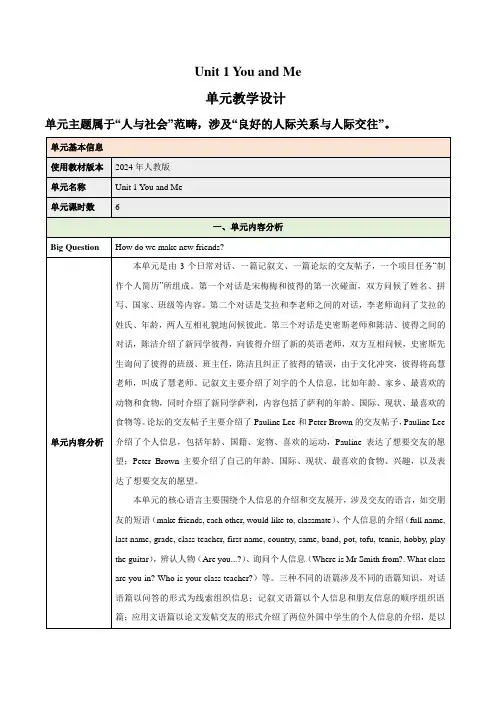
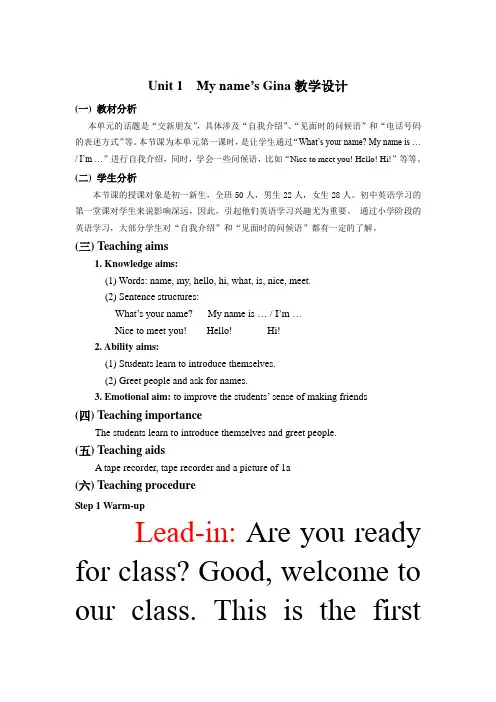
Unit 1 My name’s Gina教学设计(一) 教材分析本单元的话题是“交新朋友”,具体涉及“自我介绍”、“见面时的问候语”和“电话号码的表述方式”等。
本节课为本单元第一课时,是让学生通过“What’s your name? My name is … / I’m …”进行自我介绍,同时,学会一些问候语,比如“Nice to meet you! Hello! Hi!”等等。
(二) 学生分析本节课的授课对象是初一新生,全班50人,男生22人,女生28人。
初中英语学习的第一堂课对学生来说影响深远,因此,引起他们英语学习兴趣尤为重要。
通过小学阶段的英语学习,大部分学生对“自我介绍”和“见面时的问候语”都有一定的了解。
(三) Teaching aims1. Knowledge aims:(1) Words: name, my, hello, hi, what, is, nice, meet.(2) Sentence structures:What’s your name? My name is … / I’m …Nice to meet you! Hello! Hi!2. Ability aims:(1) Students learn to introduce themselves.(2) Greet people and ask for names.3. Emotional aim: to improve the students’ sense of making friends(四) Teaching importanceThe students learn to introduce themselves and greet people.(五) Teaching aidsA tape recorder, tape recorder and a picture of 1a(六) Teaching procedureStep 1 Warm-upLead-in: Are you ready for class? Good, welcome to our class. This is the firstEnglish class. Let’s have a survey to see how many English words you know. Please open your books at page 1, look at the picture in 1a Section A and write down the words for the things you know.1. The teacher shows the picture.2. The students write down the words they know in the book.3. Ask the students to report what they write.T: Ok, have you finished? If you finish, please hands up!Ss: Yes. (Most of the students raise their hands)T: Very good, I’d like to ask someone to come to the front of the class to point the things, call out and spell thewords you have written down, who’d like to try?4. The students spell the words and the teacher writes the words on the blackboard while they are spelling.T (after writing): Well done, now please read after me. Now, boys read, each for three times.Boys: clock …T: Now it’s the girls’ turn.Girls: clock …Step 2 Introduce oneself and greet peopleLead-in: Now, I know you have learnt English and you will go on learning it. I’m your new English teacher. I want to be your friend, but I do not know your names. First, let me introduce myself.1. The teacher shows a model together with a student.T: My name is …What’s your name?S: My name is …T: Hello! xxx. Nice to meet you.S: Hi! xxx. Nice to meet you, too.(The teacher shakes hands with the students while greeting, repeating it with “I’m …and other names”)2. The teacher writes the dialogue on the blackboard.3. The students follow to read words or sentences with the teacher if necessary.4. The students introduce themselves and greet their partners.T: Now, please introduce yourself to your partners and greet them.(The teacher walks around the room to see if any help is needed)5. The teacher gets some pairs to share with the class.6. Ask the students to read 1a after the recording. Repeat each sentence for three times.7. Ask the students to listen to 1b and number the conversations 1-38. Play the recording, check the answers and tell the students some pronunciation notes.9. Ask the students to repeat the dialogue in 1b after the recording. Repeat each sentence for three times.Step 3 Use the target language to make new friendsLead-in: you have learnt how to introduce yourself, and greet people. Now I think you can make more friends in this way. Ok, please leave your seats to make a new friend.1. The students work in pairs freely while T moves around the classroom offering support where needed.2. The students act out their dialogues by some pairs when they are ready.3. The teacher and the students make assessment.Assignments:(1) Read the dialogue in 1a.(2) Finish the exercise book on page 1.。
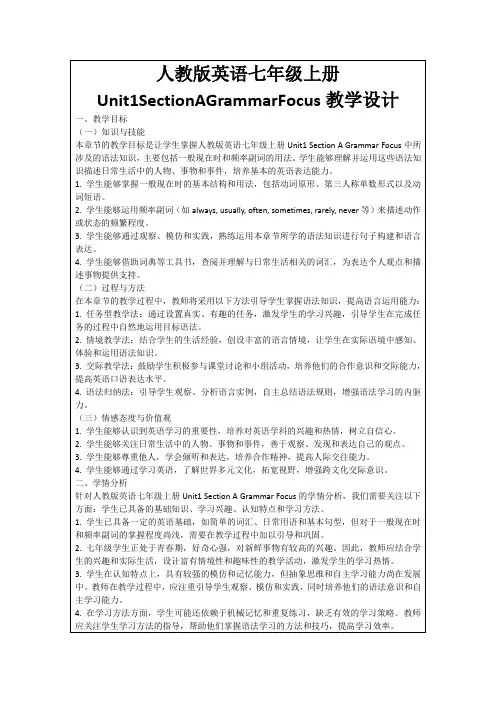
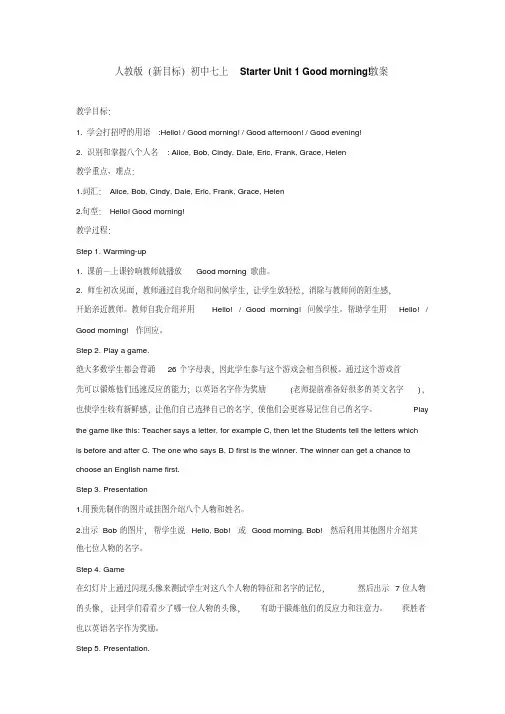
人教版(新目标)初中七上Starter Unit 1 Good morning!教案教学目标:1. 学会打招呼的用语:Hello! / Good morning! / Good afternoon! / Good evening!2. 识别和掌握八个人名: Alice, Bob, Cindy, Dale, Eric, Frank, Grace, Helen教学重点、难点:1.词汇:Alice, Bob, Cindy, Dale, Eric, Frank, Grace, Helen2.句型:Hello! Good morning!教学过程:Step 1. Warming-up1. 课前—上课铃响教师就播放Good morning歌曲。
2. 师生初次见面,教师通过自我介绍和问候学生,让学生放轻松,消除与教师间的陌生感,开始亲近教师。
教师自我介绍并用Hello! / Good morning! 问候学生。
帮助学生用Hello! / Good morning! 作回应。
Step 2. Play a game.绝大多数学生都会背诵26个字母表,因此学生参与这个游戏会相当积极。
通过这个游戏首先可以锻炼他们迅速反应的能力;以英语名字作为奖励(老师提前准备好很多的英文名字),也使学生较有新鲜感,让他们自己选择自己的名字,使他们会更容易记住自己的名字。
Play the game like this: Teacher says a letter, for example C, then let the Students tell the letters whichis before and after C. The one who says B, D first is the winner. The winner can get a chance to choose an English name first.Step 3. Presentation1.用预先制作的图片或挂图介绍八个人物和姓名。
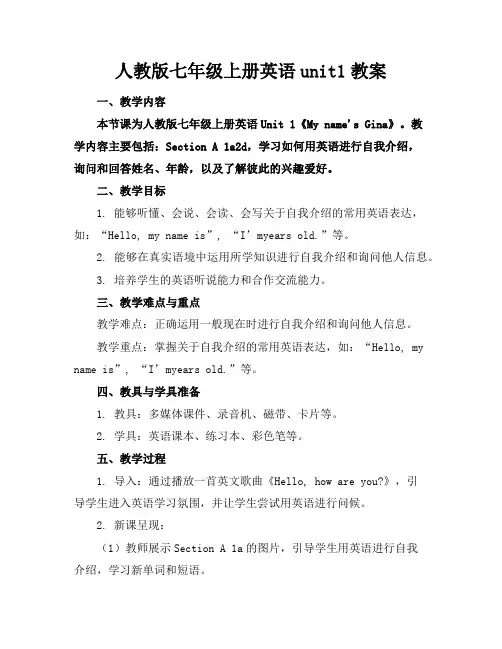
人教版七年级上册英语unit1教案一、教学内容本节课为人教版七年级上册英语Unit 1《My name's Gina》。
教学内容主要包括:Section A 1a2d,学习如何用英语进行自我介绍,询问和回答姓名、年龄,以及了解彼此的兴趣爱好。
二、教学目标1. 能够听懂、会说、会读、会写关于自我介绍的常用英语表达,如:“Hello, my name is”, “I’myears old.”等。
2. 能够在真实语境中运用所学知识进行自我介绍和询问他人信息。
3. 培养学生的英语听说能力和合作交流能力。
三、教学难点与重点教学难点:正确运用一般现在时进行自我介绍和询问他人信息。
教学重点:掌握关于自我介绍的常用英语表达,如:“Hello, my name is”, “I’myears old.”等。
四、教具与学具准备1. 教具:多媒体课件、录音机、磁带、卡片等。
2. 学具:英语课本、练习本、彩色笔等。
五、教学过程1. 导入:通过播放一首英文歌曲《Hello, how are you?》,引导学生进入英语学习氛围,并让学生尝试用英语进行问候。
2. 新课呈现:(1)教师展示Section A 1a的图片,引导学生用英语进行自我介绍,学习新单词和短语。
(2)教师播放1b的录音,学生跟读,学习正确的发音。
(3)学生两人一组,根据2a的提示,互相提问并回答关于姓名、年龄、兴趣爱好等问题。
3. 情景交际:(1)教师创设真实语境,引导学生运用所学知识进行自我介绍和询问他人信息。
(2)学生分角色进行角色扮演,模拟真实场景。
4. 例题讲解:(1)教师讲解一般现在时的用法,并结合例句进行展示。
(2)学生完成Section A 2b的练习,巩固一般现在时的用法。
5. 随堂练习:(1)学生完成Section A 2c的练习,进行听力训练。
(2)学生两人一组,根据2d的提示,互相提问并回答问题。
(1)教师邀请学生分享本节课的学习收获。
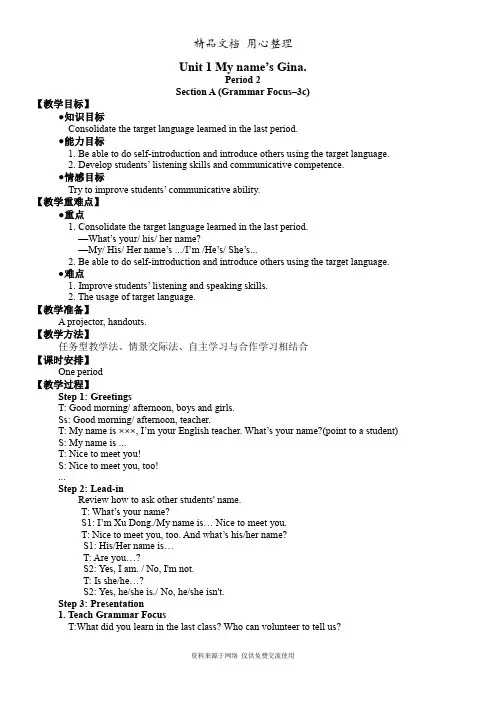
Unit 1 My name’s Gina.Period 2Section A (Grammar Focus–3c)【教学目标】●知识目标Consolidate the target language learned in the last period.●能力目标1. Be able to do self-introduction and introduce others using the target language.2. Develop students’ listening skills and communicative competence.●情感目标Try to improve students’ communicative ability.【教学重难点】●重点1. Consolidate the target language learned in the last period.—What’s your/ his/ her name?—My/ His/ Her name’s .../I’m /He’s/ She’s...2. Be able to do self-introduction and introduce others using the target language.●难点1. Improve students’ listening and speaking skills.2. The usage of target language.【教学准备】A projector, handouts.【教学方法】任务型教学法、情景交际法、自主学习与合作学习相结合【课时安排】One period【教学过程】Step 1: GreetingsT: Good morning/ afternoon, boys and girls.Ss: Good morning/ afternoon, teacher.T: My name is ×××, I’m your English teacher. What’s your name?(point to a student) S: My name is ...T: Nice to meet you!S: Nice to meet you, too!...Step 2: Lead-inReview how to ask other students' name.T: What’s your name?S1: I’m Xu Dong./My name is… Nice to meet you.T: Nice to meet you, too. And what’s his/her name?S1: His/Her name is…T: Are you…?S2: Yes, I am. / No, I'm not.T: Is she/he…?S2: Yes, he/she is./ No, he/she isn't.Step 3: Presentation1. Teach Grammar FocusT:What did you learn in the last class? Who can volunteer to tell us?S1:Me. We’ve learned how to introduce ourselves.S2:We’ve learned the use of verb be.S3:We’ve learned the possessive pronounces.T:Great! Today we’ll consolidate what we’ve learned in the last class.(1) Ask students to open their book, and turn to Page 3. Read through the sentences in the box.(2) Ask students to write down their answers to the questions, and substitute the names of the names of students in the box.(3) Leave students several minutes to do the task.(4) Collect their answers. Correct mistakes if there is any.(5) Ask students to read the short forms in the box. Pay attention to the pronunciation.2. Teach activity 3a(1) Look at 3a. Tell Ss to put the words in order to make conversations. Pay attention to theright sentence structure. Ss work with their partners. Try to make conversations with the given words.(2) Check the answers. Encourage some pairs to act out the dialogue. See if their dialogues are right.(3) Ss read the dialogue aloud after the teacher. Then try to practice the dialogues with their partners.(4) Let some pairs to act out the dialogue in front of the class.Step 4: Practice1. Teach activities 3b(1) Look at 3b. Tell Ss to complete conversation. Pay attention to the right sentence structure.Ss work with their partners. Try to make conversation.(2) Check the answers. Encourage some pairs to act out the conversations. See if their answers are right.(3) Ss read the conversations aloud after the teacher. Then try to practice the conversations with their partners.(4) Let some pairs to act out the conversations in front of the class.2. Teach activity 3c(1) Now, each of you has an English name. So we have learnt many names about boys and girls. Do you know how many foreign names? Let's do a "Name game".Competition: list names as many as possible, see which group gets the most names.(2) Divide the Ss into groups of six or more. Each group has four or six students.(3) Tell Ss how to play the game. Make a model for the Ss.S1: My name is Jenny.S2: Her name is Jenny. My name is Tony.S3: Her name is Jenny. His name is Tony…My name is June.S4: …(4) Ss play the game in their groups first. Then have a competition. See which group is the best.Step 5: ConsolidationSum up the possessive pronouns “my, your, his, her...”.Do exercises:1. What’s (你的) name?2. (我的) name is Jenny.= Jenny.3. What’s (他的) name?4. (他的) name is Tony.5. What’s (她的) name?6. (她的) name is Gina.Invite volunteers to present the answers.Answers:1.your 2. My; I’m 3.his 4.His 5.her 6.Her【课堂小结】In this period, we’ve consolidated what we’ve learned in the last period through some practice and games.【课后作业】1. Read the sentences in Grammar Focus.2. Make some conversations by yourself.。
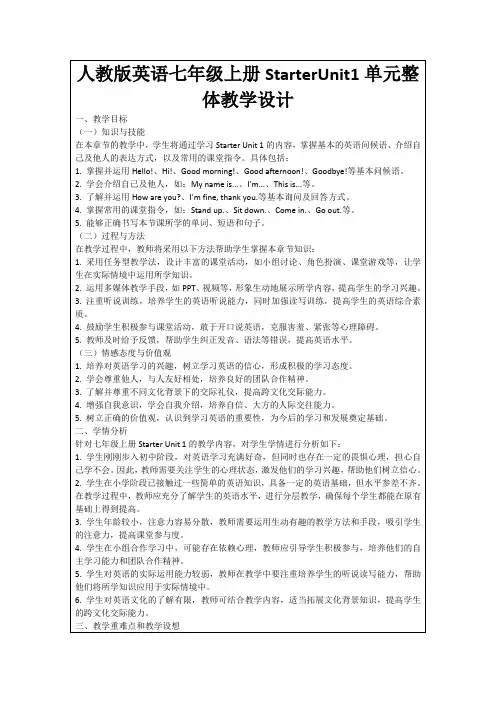
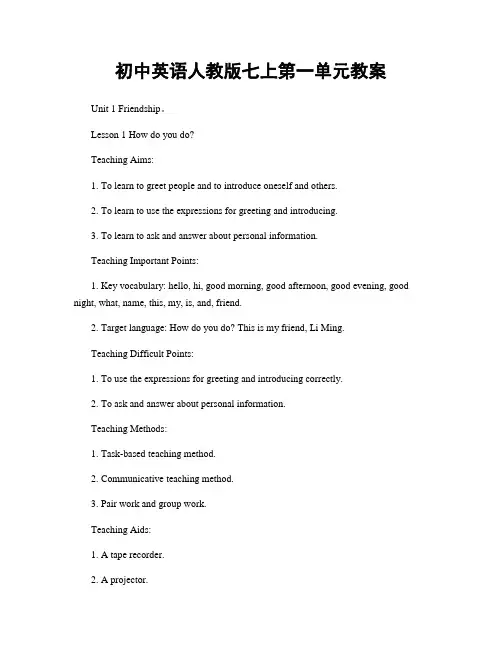
初中英语人教版七上第一单元教案Unit 1 Friendship。
Lesson 1 How do you do?Teaching Aims:1. To learn to greet people and to introduce oneself and others.2. To learn to use the expressions for greeting and introducing.3. To learn to ask and answer about personal information.Teaching Important Points:1. Key vocabulary: hello, hi, good morning, good afternoon, good evening, good night, what, name, this, my, is, and, friend.2. Target language: How do you do? This is my friend, Li Ming.Teaching Difficult Points:1. To use the expressions for greeting and introducing correctly.2. To ask and answer about personal information.Teaching Methods:1. Task-based teaching method.2. Communicative teaching method.3. Pair work and group work.Teaching Aids:1. A tape recorder.2. A projector.Teaching Procedures:Step 1. Warm-up。
1. Greet the students with different greetings, such as "Good morning, class" and "Hello, everyone".2. Ask the students to respond to the greetings.Step 2. Presentation。
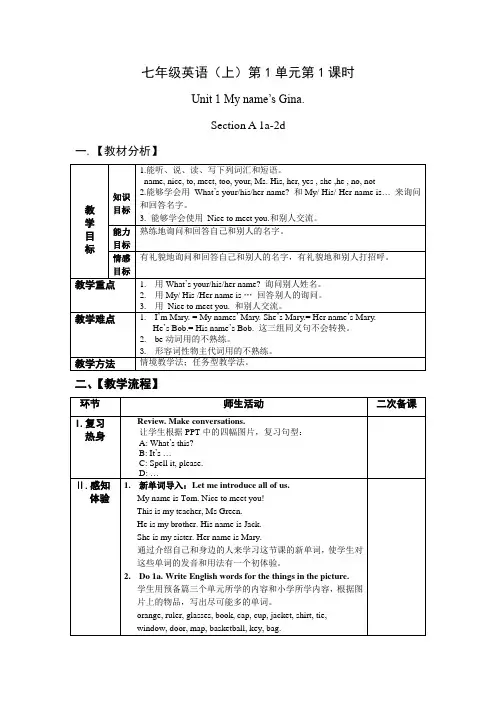
七年级英语(上)第1单元第1课时Unit 1 My name’s Gina.Section A 1a-2d一.【教材分析】二、【教学流程】环节师生活动二次备课I.复习热身Review. Make conversations.让学生根据PPT中的四幅图片,复习句型:A: What’s this?B: It’s …C: Spell it, please.D: …Ⅱ.感知体验1.新单词导入:Let me introduce all of us.My name is Tom. Nice to meet you!This is my teacher, Ms Green.He is my brother. His name is Jack.She is my sister. Her name is Mary.通过介绍自己和身边的人来学习这节课的新单词,使学生对这些单词的发音和用法有一个初体验。
2.Do 1a. Write English words for the things in the picture.学生用预备篇三个单元所学的内容和小学所学内容,根据图片上的物品,写出尽可能多的单词。
orange, ruler, glasses, book, cap, cup, jacket, shirt, tie,window, door, map, basketball, key, bag.教学目标知识目标1.能听、说、读、写下列词汇和短语。
name, nice, to, meet, too, your, Ms. His, her, yes , she ,he , no, not2.能够学会用What’s your/his/her name? 和My/ His/ Her name is…来询问和回答名字。
3. 能够学会使用Nice to meet you.和别人交流。
能力目标熟练地询问和回答自己和别人的名字。
情感目标有礼貌地询问和回答自己和别人的名字,有礼貌地和别人打招呼。
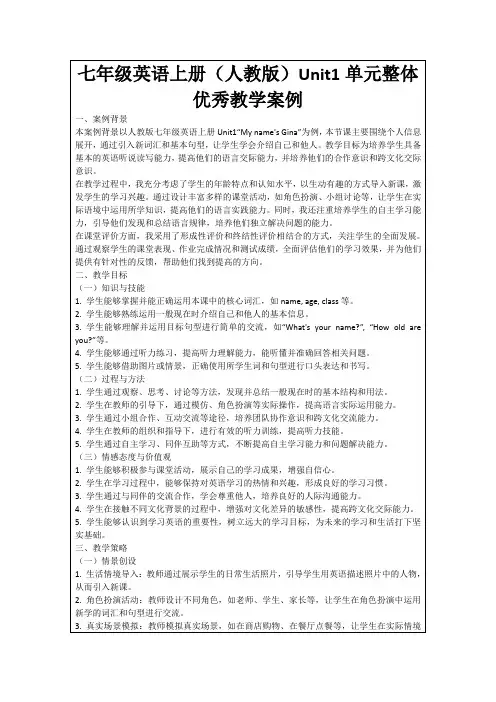
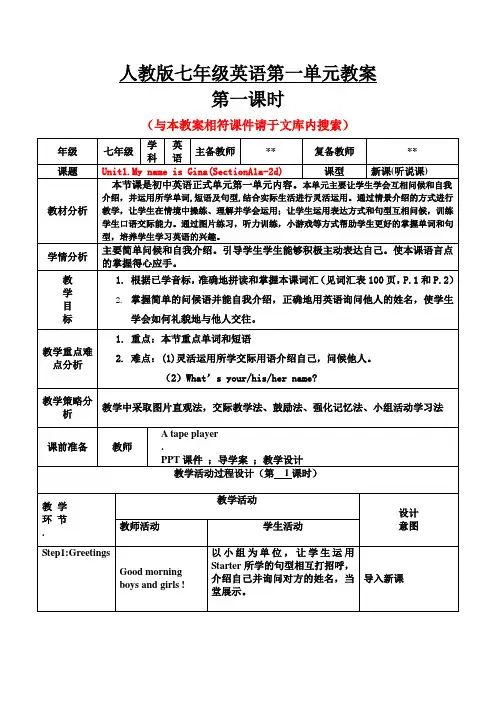
课时教学设计课时教学设计课时教学设计课时教学设计附赠材料优秀的教学是练出来的在上一堂课里,你已经学会了区分高效教学法和低效教学法之间的区别。
现在,我们还要继续巩固这一概念。
在高效教学法和低效教学法之间,是否存在一个灰色的中间地带呢?是的,这个灰色地带确实存在。
如果能带领那些还不够高效的教师们进人这一中间地带,那也是很大的进步。
当然,本课的主要目的是发掘出教师的最大潜力,以最终实现高效教学。
如果能成功做到这一点,那么你最终会发现学生的表现有了显著的提高。
显而易见,教师能力的优劣会直接影响到学生的表现。
教师越优秀,学生的表现就越好。
课程:首先,我们回顾一下上一节课所学的如何区分高效和低效教学上一节课,我已经要求你总结出自身存在的弱项,并且在课后进行针对性的练习。
今天,请你仔细思考,在下面列举的教学情景中高效和低效的教师将如何做出不同的应对措施。
高效教学与低效教学实践一个学生在课堂上一直和其他学生聊天。
他这个举动非常明显,必须及时制止。
面对这个情形时,低效的教师会如何应对?高效的教师又会如何应对?一个学生在课堂上不断发出声响,这个声音越来越吵,并且影响到了班级里的其他学生。
低效的教师会如何应对?高效的教师又会如何应对一个学生总是没有完成课后布置的家庭作业。
对这个学生低效的教师会如何应对?高效的教师又会如何应对?一个学生总是随便讲话。
教师在讲课的时候她讲话,同学们在做课堂练习的时候她讲话,午餐之前大家都应该安静等待的时候她也在讲话,在类似的其他场合她也经常随便讲话。
面对这个情形低效的教师会如何应对?高效的教师又会如何应对?学校准备开展一个新的教学项目,大家都不清楚这个项目效果如何。
为了顺利实施该项目,部分教师将被挑选出来进行培训培训过程很可能十分艰苦。
面对新项目的挑战,低效的教师会如何应对?高效的教师又会如何应对?当你回答完这些问题时,你一定会明白:高效的教师一定是个冷静、专业、细心的教师。
你愿意做这样的教师吗?如果愿意,那么就拿出你的实际行动来吧!实践:将你今天的感悟记录下来,这样可以让你意识到,自己之前的处理方式哪些是低效的手段,哪些是高效的手段。
7年级上册英语第一单元教案5篇2022以“英语课程标准”为宗旨,适应新课程改革的需要,面向全体学生,提高学生的人文素养,增强实践能力和创新精神。
正确把握英语学科特点,积极倡导合作探究的学习方式。
培养学生积极地情感态度和正确的人生价值观,提高学生综合素质为学生全面发展和终身发展奠定基础。
以下是小编带来的7年级上册英语第一单元教案内容,感谢您的阅读,希望能帮助到您!7年级上册英语第一单元教案1第2课时Unit1Myname'sGina.(总第2课时)SectionA(1a—2c)【学习目标】:1、熟练掌握本课6个单词.2、学会询问他人姓名及介绍他人姓名.3、能听懂有关谈论他人姓名的对话并进行自由交际.【学习重点】:询问他人姓名及介绍他人姓名的句型.一、自主学习(教师寄语:Knowledgeispower.)学习任务一:熟练读写本课6个单词.1.个人自渎,记忆本课单词.2.小组互相检查单词读写情况.3.根据汉语写出下列英语单词并展示.学习任务二:运用句型:What'shis/hername?His/Hernameis....进行自由交际.1.小组合作,理解并熟读下列短语,并写出汉语意思.mynane()yourname()hisname()hername()2.个人理解下列对话,并且两人合作练习.A:Hello!What'syourname?B:MynameisGina.A:Nicetomeetyou.B:Nicetomeetyou,too.A:What'shername?B:HernameisJenny.3.小组合作,练习自己的对话.4.对抗组开展竞赛,展示自己的对话.学习任务三:听听力完成2a,2b.1.个人看图,理解四幅图画,思考图画中人是在谈论他人还是对方.2.听听力,给四幅图画编号.3.小组为单位,熟读2b中的名字。
4.听听力,完成2b.二、合作共建(教师寄语:Manyhandsmakelightwork.)讨论下面两句话如何用英语表达.1.他叫Bob.2.她叫Jenny.三、系统总结(教师寄语:Nomancandotwothingsatonce.)根据提示,完成下列问答.______________What's_______name?_______is...._______________四、诊断评价1、写出下列短语.(1)我的时钟(2)你的问题(3)他的名字(4)她的回答2、根据句意及首字母补全单词。
人教版初中七年级上册英语教案(完整版)一、教学内容Unit 1 你好Lesson 1 你好吗1. 教学目标:- 研究如何问候和回应问候的方式- 掌握与他人交流的基本问答方式- 学会用英语自我介绍2. 教学重点:- 掌握如何用英语问候和回应问候的方式- 学会在对话中使用一些常见的英语短语- 能够简单介绍自己的姓名、国籍和年龄3. 教学过程:- 导入新课,引导学生复英语问候语- 引入新的问候方式和回应,通过示范和练加深学生理解- 分组进行对话练,鼓励学生运用新学的问候方式与他人交流- 引导学生进行自我介绍,帮助他们掌握相关的英语表达4. 板书设计:- 问候语- Hello!- Hi!- How are you?- I'm fine, thank you.- 自我介绍- My name is [name].- I am from [country].- I am [age] years old.5. 作业要求:- 完成课堂练册上的相关练- 准备下节课的自我介绍Lesson 2 你是谁(以下内容略去不写)Unit 2 我的家(以下内容略去不写)二、教学目标在初中七年级上册英语教学中,我们旨在通过教授Unit 1和Unit 2的内容,帮助学生学会基本的英语问候和自我介绍方式,以及描述家庭成员和家庭的基本词汇。
通过各种实践活动和练,学生将能够在日常生活中简单地应用这些英语表达方式。
三、教学方法- 情景教学法:通过创设真实情景,引导学生使用所学知识进行对话练。
- 归纳法:通过提供示范和练,让学生总结语言规律和表达方式。
四、教学资源- 人教版初中英语教材《七年级上册》- 课件和多媒体设备- 课堂练册五、教学评估通过课堂练、对话练和个人介绍的方式,对学生对所学内容的掌握程度进行评估。
六、教学反馈及时反馈学生的研究情况,鼓励他们在研究过程中的积极表现,并针对学生的不足之处提出改进建议。
七、教学改进根据学生的研究情况和反馈意见,不断优化课堂教学过程,提高学生的研究效果。
人教版七年级英语上册第一单元教学案第1课时Unit 1 My name 's Gina (总第1课时)Section A 1a—2c【学习目标】:1、熟悉掌握词汇name clock 等2、学会介绍自己并询问他人姓名,能够利用所学知识进行打招呼.3、能听懂听力对话并能对根据听力对话进行自由交际.【学习重点】:使学生学会打招呼和介绍自己,并询问他人姓名的句型.Nice to meet you . What's your name ? My name is ......【学习过程】:一、自主学习(教师寄语:Knowledge is power.)学习任务一: 熟悉掌握词汇name ,clock1、认真观察第一页的图画,小组讨论你所认识的物品的英语单词.2,、试着写出含有的物品的英语单词.3、小组竞赛,展示( 看谁总结的多, 写的准确)学习任务二: 学会介绍自己并询问他人姓名,能够利用所学知识进行打招呼.1、教师自我介绍,引导学生介绍自己.A: Hello , I am Gina , What's your name ?B: My name is Alan .2、小组竞赛, 两人一组,询问他人姓名,介绍自己.3,、分角色朗读1A对话.学习任务三: 能听懂听力对话并能对根据听力对话进行自由交际.1,、听录音, 给1B 的对话编号.2、根据听力对话进行自由交际.3、小组竞赛, 展示对话交际。
二、合作共建(教师寄语:Many hands make light work. )小组讨论我们所学的英语名字和汉语名字的区别, 如何用英语拼写你的名字?三、系统总结(教师寄语:No man can do two things at once.)1,、归纳你所学到的问候语.2、自己编写一个打招呼并询问姓名的小对话.四、诊断评价(一)单项选择.1. _______your name ? My name is Gina .A. WhatB. What'sC. WhoD. which2. Good morning , Miss Wang ! _____________!A. HelloB.HiC. Nice to meet youD. Good morning3. I _______Sally , What______ your name ?A. am ,isB. is , amC. is , isD.am, am4. ______name is Li lei .A. IB. I amC. MyD. you5.— _______, What's your name ?— John Green .A. HiB. OkC. sorryD. Excuse me(二)写出下列单词的完全形式, 并写出汉语意思.I'm _________ __________ what's __________ ________name 's ___________ __________(三)写出下列单词.时钟_______ 我的________ 你的___________ 名字_______ 遇见_________ (四)尝试翻译下列句子.1. 见到你很高兴. _________________________________.2.我叫王小雨. ____________________________________.3. 你叫什么名字? ____________________________________(五)根据情景补全对话.A: Good afternoon !B: ____________________!A; I ______Lucy . _________your name ?B: My ______ is Jim . Nice to ______you !A: _______________________________.五、【课后反思】(教师寄语:Never do things by halves)任务熟练掌握基本掌握没掌握第2课时Unit 1 My name 's Gina.(总第2课时)Section A (1a—2c)【学习目标】:1、熟练掌握本课6个单词.2、学会询问他人姓名及介绍他人姓名.3、能听懂有关谈论他人姓名的对话并进行自由交际. 【学习重点】:询问他人姓名及介绍他人姓名的句型.一、自主学习(教师寄语:Knowledge is power.)学习任务一: 熟练读写本课6个单词.1.个人自渎,记忆本课单词.2.小组互相检查单词读写情况.3.根据汉语写出下列英语单词并展示.学习任务二: 运用句型:What's his / her name?His / Her name is .... 进行自由交际.1.小组合作,理解并熟读下列短语,并写出汉语意思.my nane ( ) your name ( )his name ( ) her name ( )2.个人理解下列对话,并且两人合作练习.A:Hello! What's your name?B:My name is Gina.A:Nice to meet you.B:Nice to meet you,too.A:What's her name?B:Her name is Jenny.3.小组合作,练习自己的对话.4. 对抗组开展竞赛,展示自己的对话.学习任务三: 听听力完成2a,2b.1.个人看图,理解四幅图画,思考图画中人是在谈论他人还是对方.2.听听力,给四幅图画编号.3. 小组为单位,熟读2b中的名字。
4.听听力,完成2b.二、合作共建(教师寄语:Many hands make light work. )讨论下面两句话如何用英语表达.1.他叫Bob.2.她叫Jenny.三、系统总结(教师寄语:No man can do two things at once.)根据提示,完成下列问答._______ _______What's _______ name? _______ is ...._______ ________四、诊断评价1、写出下列短语.(1)我的时钟(2)你的问题(3)他的名字(4)她的回答2、根据句意及首字母补全单词。
(1)_________is your name ?(2)Nice to m________you.(3)His a _________is good.(4)L______! His clock is beautiful(漂亮的).三、选择1. _______, What's his name? His name is John Green.A. HiB. OhC. SorryD. OK2. She is a girl(女孩).What's ______ name?A. herB. sheC. she'sD.his五、【课后反思】(教师寄语:Never do things by halves)第3课时Unit 1 My name 's Gina (总第3课时)Section A 3a —4【学习目标】:1、熟悉掌握本节课的六个词汇。
2、正确辨别英文名字的姓和名,以及和中文名字的差异.3、学会询问他人名和姓的句型.【学习重点】:掌握询问他人名和姓的句型.【学习过程】:一、自主学习(教师寄语:Knowledge is power.)学习任务一: 熟悉掌握词汇。
1、个人自读,记忆本课单词.2、小组相互检查单词读和写的情况.3,、据汉语写出单词,小组竞赛并展示.学习任务二: 能运用句型:What's your first name ?My first name is....What's your last name?My last name is...进行交际.1、试读下列姓名,尝试总结归纳.Gina MillerFirst name :________ Last name: ________完成3a .(让对抗号在黑板上展示)2、理解下列对话,两人合作练习.A: Hello! What's your name?B: My name is Jack Smith.A: What's your first name ?B: My first name is....A: What's your last name?B: My last name is...3、小组合作,练习自己的对话.4、对抗小组开展竞赛,展示自己的对话.(完成3b)二、合作共建(教师寄语:Many hands make light work. )学会了询问他人的名和姓的句型后,能否用his/her做替换练习。
三、系统总结(教师寄语:No man can do two things at once.)1、总结你所知道的名和姓。
2、自己编写一个询问他人姓和名的小对话.四、诊断评价(一)用所给词的适当形式填空.1. Nice to meet ______(your).2. _____(she) name is Helen Black.3. His family name _____(be) Mr Green.4. ______(be) you Mr Green.5. Hi, I _____(be) Lily.(二)据汉语完成句子1. Brown 是他的姓氏. Brown is ______________name.2. 她的名是什么? ____________________name?3. 你好,我是杰克. Hi, ________Jack.4. 我的钢笔是黑色的. _____pen is ______.5. 他的名字是吉姆. _______________Jim.(三)根据上下文完成对话.A: Hello!B: ________!A: I'm Gina,________________?B: My name is Linda Brown.A: Is Linda your last name?B: No.Linda is my __________. And Brown is ___________. A: Nice to meet you.B: ____________________.。